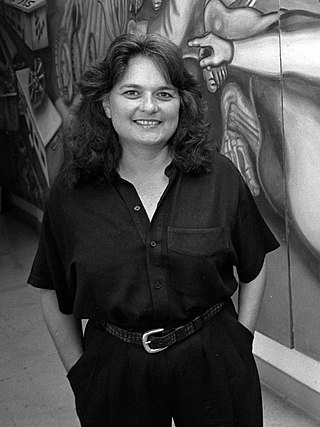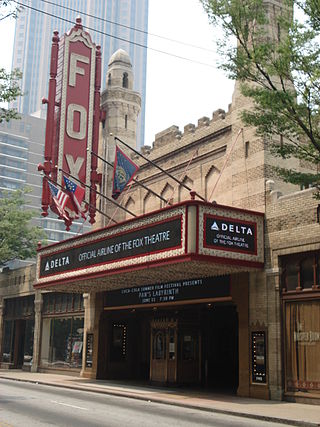A mural is any piece of artwork painted or applied directly on a wall, ceiling or other large permanent surface.
Contents
Mural may also refer to:
A mural is any piece of artwork painted or applied directly on a wall, ceiling or other large permanent surface.
Mural may also refer to:

Guadalajara is a metropolis in western Mexico and the capital of the state of Jalisco. According to the 2020 census, the city has a population of 1,385,629 people, making it the 7th most populous city in Mexico, while the Guadalajara metropolitan area has a population of 5,268,642 people, making it the third-largest metropolitan area in the country and the twentieth largest metropolitan area in the Americas Guadalajara has the second-highest population density in Mexico, with over 10,361 people per square kilometer. Within Mexico, Guadalajara is a center of business, arts and culture, technology and tourism; as well as the economic center of the Bajío region. It usually ranks among the 100 most productive and globally competitive cities in the world. It is home to numerous landmarks, including Guadalajara Cathedral, the Teatro Degollado, the Templo Expiatorio, the UNESCO World Heritage site Hospicio Cabañas, and the San Juan de Dios Market—the largest indoor market in Latin America.

Diego María de la Concepción Juan Nepomuceno Estanislao de la Rivera y Barrientos Acosta y Rodríguez, known as Diego Rivera, was a prominent Mexican painter. His large frescoes helped establish the mural movement in Mexican and international art.

A thrombus, colloquially called a blood clot, is the final product of the blood coagulation step in hemostasis. There are two components to a thrombus: aggregated platelets and red blood cells that form a plug, and a mesh of cross-linked fibrin protein. The substance making up a thrombus is sometimes called cruor. A thrombus is a healthy response to injury intended to stop and prevent further bleeding, but can be harmful in thrombosis, when a clot obstructs blood flow through healthy blood vessels in the circulatory system.

José Clemente Orozco was a Mexican caricaturist and painter, who specialized in political murals that established the Mexican Mural Renaissance together with murals by Diego Rivera, David Alfaro Siqueiros, and others. Orozco was the most complex of the Mexican muralists, fond of the theme of human suffering, but less realistic and more fascinated by machines than Rivera. Mostly influenced by Symbolism, he was also a genre painter and lithographer. Between 1922 and 1948, Orozco painted murals in Mexico City, Orizaba, Claremont, California, New York City, Hanover, New Hampshire, Guadalajara, Jalisco, and Jiquilpan, Michoacán. His drawings and paintings are exhibited by the Carrillo Gil Museum in Mexico City, and the Orozco Workshop-Museum in Guadalajara. Orozco was known for being a politically committed artist, and he promoted the political causes of peasants and workers.
Alma or ALMA may refer to:
Hole in the Wall may refer to:

Street art is visual art created in public locations for public visibility. It has been associated with the terms "independent art," "post-graffiti", "neo-graffiti" and guerrilla art.

Ciudad Universitaria is the main campus of the National Autonomous University of Mexico (UNAM), located in Coyoacán borough in the southern part of Mexico City. Designed by architects Mario Pani and Enrique del Moral, it encloses the Olympic Stadium, about 40 faculties and institutes, the Cultural Center, an ecological reserve, the Central Library, and a few museums. It was built during the 1950s on an ancient solidified lava bed in Coyoacán called "El Pedregal" to replace the scattered buildings in downtown Mexico City where classes were given. It was completed in 1954 at a cost of approximately $25 million. At the time of its completion it was the largest single construction project in Mexico since the Aztecs. It was declared a World Heritage Site by UNESCO in 2007.

Roberto Montenegro Nervo was a painter, muralist and illustrator, who was one of the first to be involved in the Mexican muralism movement after the Mexican Revolution. His most important mural work was done at the former San Pedro and San Pablo monastery but as his work did not have the same drama as other muralists, such as Diego Rivera, he lost prominence in this endeavor. Most of his career is dedicated to illustration and publishing, portrait painting and the promotion of Mexican handcrafts and folk art.

Luis Nishizawa was a Mexican artist known for his landscape work and murals, which often show Japanese and Mexican influence. He began formal training as an artist in 1942 at the height of the Mexican muralism movement but studied other painting styles as well as Japanese art. In addition to painting canvases and murals, including murals made with ceramics, he was a professor of fine arts at the Universidad Nacional Autónoma de México from which he received an honorary doctorate. The State of Mexico, where he was born, created the Museo Taller Luis Nishizawa to honor and promote his life's work.
José Raúl Anguiano Valadez was a notable Mexican painter of the 20th century, part of the “second generation” of Mexican muralists which continued the tradition of Diego Rivera, José Clemente Orozco and David Alfaro Siqueiros but experimented with it as well. Anguiano was born during the height of the Mexican Revolution, which would inspire a majority of his mural painting. He studied painting in his hometown of Guadalajara before moving to Mexico City to begin his career. His first major exhibition was held at the Palacio de Bellas Artes, at age 20. His works include over 100 individual and collective exhibitions with 50 murals, mostly in Mexico and the United States. As he continued his artistry with aspects of the Mexican muralism movement, he also experimented with other styles such as Cubism, Surrealism and Expressionism, with themes such as clowns and prostitutes. However, his most famous painting is “La espina” which depicts a Mayan woman digging a thorn out of her foot with a knife. His later works concentrated on depicting Mexico in vivid colors and traditional imagery.

Judith Francisca Baca is an American artist, activist, and professor of Chicano studies, world arts, and cultures based at the University of California, Los Angeles. She is the co-founder and artistic director of the Social and Public Art Resource Center (SPARC) in Venice, California. Baca is the director of the mural project that created the Great Wall of Los Angeles, which is the largest communal mural project in the world.

The culture of San Antonio reflects the history and culture of one of the state's oldest and largest cities straddling the regional and cultural divide between South and Central Texas. Historically, San Antonio culture comes from a blend of Central Texas and South Texas (Southwestern) culture. Founded as a Spanish outpost and the first civil settlement in Texas, San Antonio is heavily influenced by Mexican American culture due to Texas formerly being part of Mexico and, previously, the Spanish Empire. The city also has significant German, Anglo, and African American cultural influences. San Antonio offers a host of cultural institutions, events, restaurants and nightlife in South Texas for both residents and visitors alike.
Jesús Guerrero Galván was a Mexican artist, a member of the Mexican muralism movement of the early 20th century. He began his career in Guadalajara but moved to Mexico City to work on mural projects in the 1930s for the Secretaría de Educación Pública and Comisión Federal de Electricidad In addition, he did easel paintings, with major exhibitions in the United States and Mexico. In 1943, he was an artist-in-residence for the University of New Mexico, painting the mural Union of the Americas Joined in Freedom, considered to be one of his major works. Guerrero Galván was accepted as a member of the Salón de la Plástica Mexicana.

Gabriel Flores was a Mexican painter and muralist born in Guadalajara, Jalisco. Between 1956 and 1993, his murals focused on historical and universal themes, as well as the ability of art functioning as social commentary. In the 1960s, at the height of his career, he created his magnum opus Los Niños Héroes, depicting the sacrifice of six child soldiers during the Mexican-American War. Gabriel Flores described himself, saying "I do not want much; I have what I like, above all my freedom."

Various types of visual arts developed in the geographical area now known as Mexico. The development of these arts roughly follows the history of Mexico, divided into the prehispanic Mesoamerican era, the colonial period, with the period after Mexican War of Independence, the development Mexican national identity through art in the nineteenth century, and the florescence of modern Mexican art after the Mexican Revolution (1910-1920).

The arts in Atlanta are well-represented, with a prominent presence in music, fine art, and theater.
Jesús Reyes Ferreira, (1880-1977) born José de Jesús Benjamín Buenaventura de los Reyes y Ferreira and also known as Chucho Reyes, was a self-taught artist and antiques/art collector and vendor. Reyes Ferreira began painting on crêpe paper, a delicate material not meant to last, as a way of decorating paper meant to wrap sales from his antiques/art store. The decorated paper became popular enough to be sold on its own. Although he began this activity in Guadalajara, he did not produce the bulk of his work until after he moved to Mexico City when he was 58 years old. Here he continued collecting and selling objects such as colonial art and Mexican handcrafts and folk art, being one of the early exponents for the appreciation of these objects. He also spent several hours a day painting. His work was first exhibited in 1950 with his first individual exhibition in 1967 at the Palacio de Bellas Artes after a half century of painting. As a self-taught painter, his works are relatively simple and often are dismissed as folk painting but they were and his aesthetics were praised by famous artists and architects at the time.

Elis Paprika is an independent musician, singer, songwriter, and activist from Guadalajara, Mexico, active in Mexico's Rock scene since 2004. She has performed in important music venues such as Auditorio Nacional in México City (with Julieta Venegas in 2007, Belanova in 2008, and Juan Gabriel in 2009., and Hidden Agenda in Hong Kong, as well as performing in international music festivals like Vive Latino in México City ,, Playtime in Ulaanbaatar Mongolia, Meet in Beijing in China, and Altavoz in Medellín, Colombia. Elis Paprika has also performed internationally in North and South America, South East and East Asia, and Europe. She was named "Artist of the Month" on MTV Latin America in August 2006. Musicians in her band have varied throughout the years, and her current live and recording band is called The Black Pilgrims. Elis started her career in Guadalajara Jalisco, Mexico.
Michael Kirby is a street artist who was born in Baltimore, Maryland, United States. His work has been featured and exhibited across the world for governments, cities, museums, and corporations.